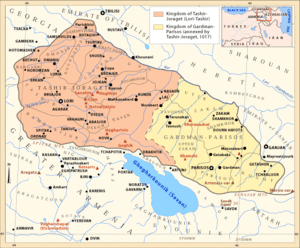Kingdom of Tashir-Dzoraget
| Kingdom of Tashir-Dzoraget | |||||
| Տաշիր-Ձորագետի Թագավորություն | |||||
| |||||
 Kingdom of Tashir-Dzoraget c. 1017 A.D. | |||||
| Capital | Lori Berd, Matsnaberd | ||||
| Languages | Armenian | ||||
| Religion | Armenian Apostolic Church | ||||
| Government | Monarchy | ||||
| King | |||||
| - | 979–989 | Kiurike I | |||
| - | 1089–1118 | David II of Lori | |||
| Historical era | Middle Ages | ||||
| - | Established | 979 | |||
| - | Kiurike I becomes the first ruler. | 979 | |||
| - | David II transfers and rules in Matsnaberd till 1118, some of his heirs continue existence to lesser extent till later. | ||||
| - | Disestablished | 1118 | |||
Kingdom of Tashir-Dzoraget (Armenian: Տաշիր-Ձորագետի Թագավորություն Tashir-Dzorageti t'agavorut'yun), alternatively known as the Kingdom of Lori or Kiurikian Kingdom, was a medieval Armenian kingdom located on the territories of modern-day Armenia, Azerbaijan and Georgia. The name Kiurike was the local form of Gurgen, the name of the first king of the dynasty.[1]
In 979 King Smbat II of Armenia gave the province of Tashir to his brother Gurgen (Kiurike) with the title of king.[2] The branch went on to outlive the main one in Ani. It became especially strong during the reign of the King David (989–1048), who conquered some territories from Emirates of Tbilisi and Ganja, and chose Samshvilde as his residence. Later on he tried to separate from Ani's suzerainty, but was punished by Gagik I. His lands were confiscated, which earned him the epithet "Anhoghin" or "the Landless." David was succeeded by Kiurike II (r. 1048–89), who was bestowed by the Byzantines with the title of curopalates.
In 1065 Lori Berd became the capital of the kingdom. In 1118 the kingdom became part of Georgian kingdom.
Unlike their Bagratuni relatives, the Kiurikian kings were unique in minting their own coins, with the line, "May the Lord aid Kiurike (George) the Khorapaghat (Curopalates)," running in five lines inscribed on the reverse side.[3] They sponsored the construction of a number of churches and monasteries in northern Armenia, including those in Sanahin, Haghpat and Haghartsin,[4] where a great many of them were interred.[5]
References
- ↑ (Armenian) Matevosyan, Raphael I. (1976). "Տաշիր-Ձորագետը և Հայաստանի Հյուսիս-Արևմտյան Գավառները IX-XI Դարերում," [Tashir-Dzoraget and the north-western regions of Armenia in the ninth to eleventh centuries] in Հայ Ժողովրդի Պատմություն [History of the Armenian People], eds. Tsatur Aghayan et al. Yerevan: Armenian Academy of Sciences, vol. 3, pp. 100-05.
- ↑ (French) Movsesian, Łevond. "Histoire des rois Kurikian de Lori," trans. Frédéric Macler, Revue des Études Arméniennes 7, Pt. 2 (1927), 209ff.
- ↑ See Philip Grierson, "Kiurike I or Kiurike II of Loṛi-Armenia?: A Note on Attributions," American Numismatic Society Museum Notes 10 (1958), pp. 107–12.
- ↑ Ovannes Ghalpakhtchian and Adriano Alpago-Novello (1970), Sanahin, Milan: Ares.
- ↑ Manuk-Khaloyan, Armen, "In the Cemetery of their Ancestors: The Royal Burial Tombs of the Bagratuni Kings of Greater Armenia (890-1073/79)," Revue des Études Arméniennes 35 (2013), p. 168, note 124.
See also
| ||||||||||||||||||||||||

